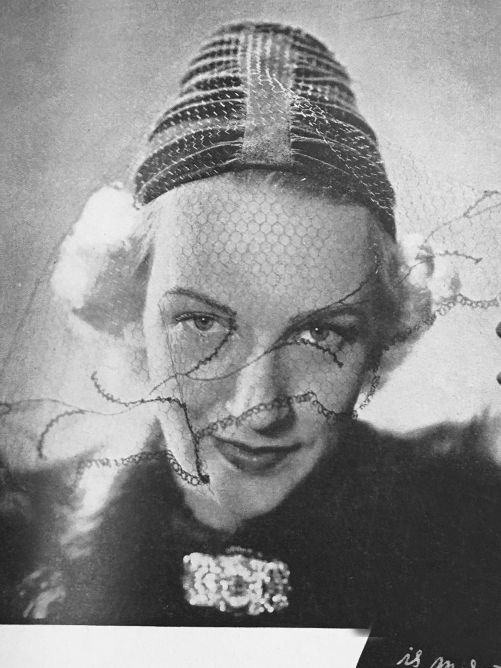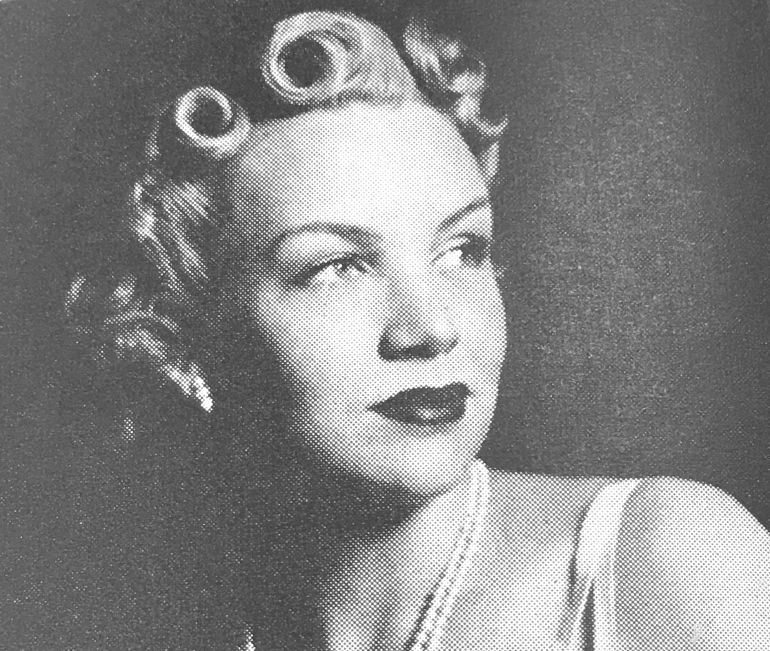Are these the eyes of a killer? Technically, no. All that was years in the future…
Back in July 1939, our scribe wrote glowingly of a young woman who graced our pages:

“A success story that we delight in telling is that of Ann Eden (Ann Crowell, as we knew her less than two years ago when she began her fashion career at Harzfeld’s). None other than our own clever Murrel (Mrs. Dinwiddie) Groves, at one time fashion director of The Independent, sensed the limitless possibilities of this slender, fair-haired girl with a decided fashion flair. Encouraged by Mrs. Groves to go to New York, Ann packed up her stack of photographs – went to New York – and here’s where we come in! Her photograph, depicting a hat that was modeled for Harzfeld’s millinery salon and which had appeared on the front cover of The Independent, August 28, 1937, was the one which earned her first assignment as a photographic fashion model. Can’t you hear Maurice Breyer [of Harzfeld’s] saying, ‘Just as I expected!’ To make a long story short, Ann Crowell, professionally Ann Eden, has in the past year and a half become one of New York’s ranking fashion models, a John Powers [modeling agency] product, and her lovely face and figure peer regularly out of the pages of Vogue and Harper’s [Bazaar] and the several other Condé Nast publications. Last season, Ann’s great love for the theatre found expression in a clever part in Noel Coward’s Set to Music starring Beatrice Lillie. During her stay in Kansas City where she was the guest of her mother, Mrs. Ethel Smiley Crowell, at the Locarno, Ann has been the attractive addition to many lovely parties including the Tracy Weltmers’ buffet supper for Colonel Peek and on the afternoon of the Fourth, when the Dinwiddie Groves were hosts of a cocktail party for the polo crowd at the Kansas City Country Club. Ann returned to New York by plane last Thursday.”
Ann may have looked the part of the stereotypical society girl, with nothing more on her mind than her latest beau, her newest frock, and the next party, but her life story was very different. Her mother, Ethel, had been a teacher prior to wedding a Kansas farmer named Jesse Crowell. The pair had a son, who died as a toddler, and a daughter. (Later the girl would be known as Ann. Census records, newspapers, books, and online accounts record her name in a variety of spellings: Angline, Angelia, Angeline, Angelina, Angie, and even Evangeline.) When Ethel decided she could no longer live with Jesse, she took the little girl with her. They settled in Kansas City, where Ethel had trouble making a living. Ann attended Westport High School. College wasn’t an option – Ethel was scraping by running a taxi service – but marriage was. Ann didn’t want it; she dreamed instead of going to New York and Hollywood, and making her mark on the world.
In New York, Ann had a variety of jobs. She was a model and an actress, known as “the most beautiful girl in radio” due to her parts in on-air serials. By one account, she was appearing as a dancer at a nightclub on the night she met William Woodward, Sr., and his son Billy, who had bumped into each other and were sitting together. In another version of the story, she met the elder Woodward first, and he introduced her to his son. If that’s the case, it seems clear he didn’t intend for her to become his daughter-in-law.

The best way to explain the Woodwards may be this: Flip through a copy of Town & Country magazine. Whatever you see – jewels, horses, private planes, exquisite apartments, and vast estates – they had it. William Woodward, Sr. was worth roughly $30 million at the time of his death in 1953. He served on the board of Hanover Bank and as chairman of the Jockey Club.
Billy’s mother, Elsie Cryder Woodward, didn’t approve of their engagement. Ann’s mother never knew of it. Ethel Smiley Crowell died in 1941. Ann and Billy were married in Seattle, Washington, in March 1943. For the marriage announcement, Ann listed her parents as the late Colonel and Mrs. Crowell. (Her father, long divorced from her mother, was working as a streetcar conductor.) The Independent didn’t print anything about the wedding: perhaps the scribe who knew Ann no longer worked at the magazine, or perhaps there had been a cooling of the friendship. Ann and Billy soon became the parents of two sons, who were born in 1944 and 1947.
To the outside world, their lives appeared idyllic, but those who were close to them witnessed some ugly scenes. Infidelity, physical fights that escalated into violence, and copious quantities of alcohol and pills (including Dexedrine, Thorazine, and Seconal) all had a part in poisoning their relationship. The truth was, though, that they just weren’t a good match. Ann and Billy spoke of divorce, separated, and reunited.
For some months in 1955, a prowler had been active in the area near their estate at Oyster Bay Cove on Long Island. On October 28th, police searched part of their property. The man in question, Paul Wirths, later admitted that he had been there. The following evening, Ann and Billy attended a dinner for the Duke and Duchess of Windsor and then returned home. Around two a.m., Ann awoke, sure someone was in the house. Opening the door, she saw the shadow of a man in the hall. The shotgun she fired was a gift from Billy – and the gun that killed him. The man who fell to the floor was Ann’s husband, and he was naked.
There’s no question that Ann killed Billy. Did she know it was Billy before she pulled the trigger? No one now alive can answer that. Elsie Woodward publicly championed her daughter-in-law, but she had her grandchildren to consider. At Elsie’s insistence, they were sent to school in Switzerland. A grand jury declined to indict Ann. (Paul Wirths, the prowler, didn’t fare as well.) The newspapers had a field day with the fact that Jesse Claude Crowell was alive – and that he thought his long-lost daughter had grown up to be Eve Arden. Ann spent most of her later years traveling, She died in New York in October 1975. She took poison because Esquire was about to publish Truman Capote’s fictional account of the Woodward case. Truman’s verdict? Murder. 1985 saw the publication of Dominick Dunne’s novel, The Two Mrs. Grenvilles, which became a television mini-series starring Ann-Margaret in 1987. This Crazy Thing Called Love, a non-fiction account by Susan Braudy, appeared in 1992. Glamour, drama, and blood – this story has it all, but unfortunately, it’s all true.